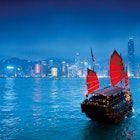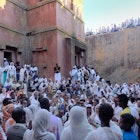
Jun 16, 2022 • 7 min read

The Cinema Imperio is but one of many Art Deco treasures lining Asmara's streets © Stephen Lioy / Photography and Travel Media
Despite a wealth of archaeological ruins, stunning Red Sea coastline, and one of the world's greatest concentrations of largely-forgotten art deco architecture, the small country of Eritrea on the Horn of Africa hasn't received much attention in tourism circles. But that is about to change.
{
"url": "now-time-visit-eritrea",
"destination": "Eritrea",
"continent": "Africa",
"country": "Eritrea"
}Eritrea has suddenly been making international news headlines recently, and for all the right reasons. Rapprochement with neighbouring Ethiopia, after more than 20 years of a low-simmering border war, has happily surprised many in the international community. And its engagement with the EU and Gulf States has started to provide economic opportunities to an otherwise underemployed population. Are loosening border controls and, dare we hope, perhaps even easier visa regimes on the horizon too?
Adventurous travelers would do well to take note, there is much to explore.

If the casual traveller knows only one thing about Eritrea, it's probably this. Added to the Unesco World Heritage list in 2017, capital city Asmara is awash with Modernist architecture left over from the Italian colonial period, most of which are notable art deco gems of a creative strain rarely seen in comparatively conservative Europe at the time of their construction.
Colonial-era cinemas and cafes line the city's main boulevards, while further into the surrounding residential neighbourhoods are the villas of the former Italian elite, which today house embassies, hotels and cultural centres.
Unesco recognises the city as 'an exceptional example of early modernist urbanism at the beginning of the 20th century and its application in an African context', but make no mistake; this is no stale fenced-off historic site, but a living city in which modern Eritreans have integrated the legacy of Italian colonialism into their everyday lives.
{
"url": "now-time-visit-eritrea",
"destination": "Eritrea",
"continent": "Africa",
"country": "Eritrea"
}
Eritrea's second city, Massawa, first gained prominence during Ottoman rule when it was built into a major Red Sea port – a factor that continued to make it an influential centre of power through the Egyptian and Italian periods and into the modern day. As a centre of Ethiopian rule in the country, Massawa was also the site of one of the most famous battles of the Eritrean war for independence, Operation Fenkil. The February 1990 battle, which resulted in Eritrea forces liberating the city from Ethiopian rule, and later aerial bombardments by the Ethiopian Air Force, left Massawa's old town in the state of ruin that still exists today. Ottoman, Egyptian and Italian-era architecture dot the old town in various states of disrepair, lending an odd dilapidated but lived-in air to the city.

Regarded by contemporaries as a power on par with Persia, China and Rome, the once-powerful Kingdom of Aksum, which dominated the area from 4th century BC to almost 1000 AD, now lives on only as archaeological sites in the dust of modern-day Eritrea and Ethiopia. Visitors to Eritrea can still see the windswept ruins of the 10th-century cities found at Qohaito and Adulis, the latter of which offers a limited but compelling look at the remnants of what was once a major export market for ivory, slaves and other commodities sent from the interior of the Aksumite Empire.
Though excavations at Adulis begun in 1840, they stalled in the early 1960s and much of the former port remains covered by the desert sands that extend nearly 5km to the modern shore of the Red Sea. However, the uncovered ruins of a large 5th-century basilica and several residential structures interspersed throughout the desert scrub give testament to the size of the former settlement, if not its full importance.
{
"url": "now-time-visit-eritrea",
"destination": "Eritrea",
"continent": "Africa",
"country": "Eritrea"
}Further inland, on the former camel track between Adulis and Aksum in northern Ethiopia, Qohaito dominates a clifftop plateau at the intersection of the Great Rift Valley and Red Sea coast. Long an important trading route, the settlement gained true prominence during the thriving Aksumite era, and the few standing archeological remains – temples, tombs and petroglyphs – are thought to date primarily from this period.

Marking the entry to the northern highlands of Eritrea, the city of Keren (highland in the Tigrinya language) is also the centre of life for several ethnic groups that inhabit the surrounding rural areas. Of note throughout history as a major market centre for the region (and particularly popular with Eritrea's few modern international tourists for the weekly Monday market and nearby camel and livestock market), the city took on a particular importance as a bastion of Italian resistance against the armies of the Commonwealth during World War II. Though the important battle sites of the era have long since faded back into the surrounding desert, the paired Italian and Commonwealth cemeteries (on opposite sides of town from one another) stand as memorials to the conflict.
The centre of Keren is also still home to interesting examples of Italian-era colonial architecture, particularly the former train station that is now used as a bus terminal, while the nearby countryside hides the ruins of both an Egyptian-era fortress and a Christian monastery dating back to at least the 6th century; however, travel permits to proceed beyond the city limits have historically been difficult to procure for travellers.
Though few details have yet been announced, the official end to the war could potentially mean any number of things to the country's tourism industry. For starters, Eritrea's border regions, which have been off limits to tourists since the conflict with Ethiopia started in 1998, should conceivably become more accessible. After all, there is no longer the risk of visiting international tourists walking into a conflict zone. The long-closed border crossings were opened to much fanfare in September, which is a concrete first step in the right direction. If these crossings are open to international visitors, which is not yet clear, it will surely revolutionise travel itineraries in the Horn of Africa.
The ease of accessing visas for Eritrea is also high on the list of hoped-for developments. Long wait times and potentially unexplained rejections are currently the norm for tourist visa applications at Eritrean consulates and embassies across the world, but this may well begin to normalise. For the moment, plan for visa applications to take a long time – months, in some cases – before receiving a reply of whether your visa is confirmed as embassies communicate directly with the Ministry of Foreign Affairs in Asmara on each application individually.
A note of caution, though – despite the positive news and potential opening of the country, Eritrea has long been reported as a country with a poor records on human rights (one of the worst in the world) and an unsettling propensity for detaining citizens that speak out against the government. As such, it's best to not make any statements openly criticising the ruling regime (in public or private), and remember that currency exchange outside of official channels is illegal.
{
"url": "now-time-visit-eritrea",
"destination": "Eritrea",
"continent": "Africa",
"country": "Eritrea"
}

Jun 16, 2022 • 7 min read


Aug 4, 2020 • 4 min read






Nov 22, 2024 • 5 min read